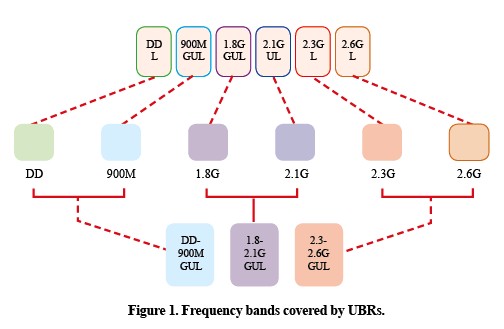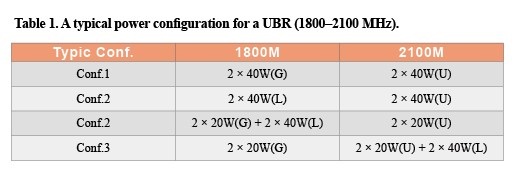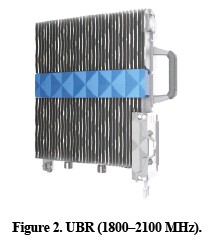ZTE UBR Leading RRU Technological Revolution
In 2006, ZTE proposed the first BBU+RRU distributed base station architecture and applied it to the TD-SCDMA network of China Mobile Qingdao. At the time, it was a revolution in wireless base station architecture. Now, the BBU+RRU distributed base station has become mainstream. It has the following advantages:
● A series of RRUs enables indoor and outdoor coverage in different scenarios.
● RRUs are small and light and can be installed flexibly. This speeds up network deployment.
● RRUs can be installed close to the antenna site. This reduces feeder loss and increases site coverage.
● The BBU has a subrack structure that leaves no footprint.
● Baseband can be shared for flexible traffic scheduling.
With these advantages, BBU and RRU are playing an increasingly important role in 2G, 3G and 4G network deployment. A state-of-the-art RRU is an important factor when an operator chooses an equipment supplier.
According to a report published by the GSA in November 2013, the number of commercial LTE networks worldwide totaled 222 in 2013, and the number of operators that had invested in LTE worldwide in 2013 was approaching 400. Operators are facing the difficulty of coexisting network standards and frequencies. To expand their existing networks or build new ones, an operator has to find extra room on an antenna site in order to install base stations or RRUs. Renting new sites for antennas is costly; therefore, operators seek to make full use of the limited site space they already have. Drawing on its rich experience with optical remote distributed base stations, ZTE has launched an ultra broadband RRU (UBR) that enables operators to use only one RRU instead of the traditional two (which operate on two frequency bands). This saves TCO.
Ultra Broadband
By using a broadband GaN power amplifier, UBR is capable of single-channel, ultra-broadband transmission. UBR also uses advanced ultra-broadband DPD architecture and algorithms to provide industry-leading transmission bandwidth of 365 MHz. A traditional RRU can only work on a single frequency band with the general bandwidth of 30–40 MHz. Therefore, six conventional RRUs are needed to cover the six major frequency bands of an operator, that is, DD, 900 MHz, 1800 MHz, 2100 MHz, 2300 MHz, and 2600 MHz. The first ZTE UBR model covers both DD and 900 MHz frequency bands with the bandwidth up to 170 MHz (790–960 MHz); the second model covers both 1800 MHz and 2100 MHz frequency bands with the bandwidth up to 365 MHz (1805–2170 MHz); the third model that is under planning will cover both 2300 MHz and 2600 MHz with the bandwidth up to 390 MHz (2300–2690 MHz). By using the UBR solution, three RRUs are needed to cover the six main frequency bands that were covered by six conventional RRUs. This greatly reduces the number of RRUs and antenna sites and saves an operator’s investment.

Compact Architecture
By using advanced cooling and internal structure interconnection technologies, ZTE’s new-generation UBR is the smallest and lightest base station in the industry. It has a 2T2R structure and transmitting power of 2 × 80 W. It is 12 L and 12 kg, so it can be installed by a single person.
Efficient Cooling System
ZTE’s new-generation UBR has a cooling mode that increases cooling efficiency by 50%, and the size of a radiator is reduced by 40%. The UBR is lighter and quieter and has a longer lifespan than a conventional RRU.
Active Duplexer
ZTE is the first equipment vendor to introduce active duplexer technology into its UBR. This reduces the size of a duplexer by 25%.
Dynamic Power Sharing
The 2 × 80 W transmitting power can be adjusted on two frequency bands, and GSM, UMTS, and LTE modes are supported on the same frequency band. This means UBR can be used in different scenarios. Table 1 lists a typical power configuration for a UBR operating at 1800–2100 MHz. The UBR can be configured in different modes according to traffic and an operator’s requirements. This saves the cost of duplicated investment.

SiteWeb
The new-generation UBR also includes a high value-added SiteWeb solution with intelligent maintenance, ambient intelligence, and video application.
● Intelligent Maintenance
In the past, a network cable was used to connect a computer to a conventional RRU during commissioning or debugging. If the RRU was installed on a tower, a maintenance technician would have to climb the tower. The SiteWeb intelligent maintenance solution uses a Wi-Fi module embedded in a UBR. This allows a maintenance technician to start the UBR maintenance application installed in a smart phone. In this way, RRUs under a tower can be commissioned or maintained. This solution greatly improves the efficiency of RRU commissioning and maintenance, and reduces OAM costs.
● Ambient Intelligence
ZTE’s new-generation UBR is a traditional 2G, 3G or 4G network element, but it also integrates M2M devices into a network in order to create more added value for operators. The ambient intelligence function enables a UBR to integrate environmental monitoring M2M devices in the cell the UBR covers. These M2M devices report the environmental information to the UBR in a timely manner, and then the UBR uploads it to the network management center for further forwarding or analysis. The environmental monitoring M2M devices that a UBR can integrate include (but are not limited to) thermometers, hygrometers, ultraviolet sensors, anemometers, and PM2.5 sensors.
● Video Application
ZTE’s new-generation UBR can also provide video service for video display devices in the cell it covers. The video display devices include outdoor advertising screens. Through network management control or intelligent terminal control with a specific application, a display device can update its content at any time as required by users.
